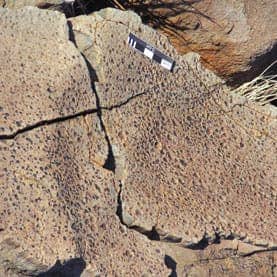Billions of years ago, the Earth was unrecognizable from the life supporting paradise it is today. Fossilized raindrops from some 2.7 billion years ago, conserved in time as rain dropped onto volcanic ash during an eruption, which eventually solidified into rock known as tuff, has revealed some very interesting facts about Earth’s ancient atmosphere. The discovery will help scientists understand more about Earth’s early history and how it evolved in time, as well as aid research funneled towards finding life bearing exoplanets.

During this period, the sun burned as much as 30% less brighter. In those conditions, the Earth should have been covered in a thick layer of ice, however geologic evidence for rivers and ocean sediments testify otherwise. This is because, at the time, the planet had an atmosphere filled with greenhouse gases which warmed it – a thick haze filled with hydrocarbons which made the Earth resemble today’s Saturn’s moon Titan.
“Because the sun was so much fainter back then, if the atmosphere was the same as it is today the Earth should have been frozen,” says Sanjoy Som, a postdoctoral researcher at NASA’s Ames Research Center.
Scientists at University of Washington in Seattle scanned the raindrop craters engraved into the ancient rock sample with lasers, and compared them with similar marks left by raindrops in ash from present time. The sizes of raindrop impressions depend on their velocity, atmospheric pressure and the composition of the material into which they fall.
The maximum raindrop diameter is around 6.8 millimeters, anything larger breaks up in smaller droplets due to the laws of physics. Considering the same laws were in place billions of years ago, raindrops during the Archean period couldn’t have been larger than this either. After a careful analysis, the researchers concluded that Earth’s early atmosphere exerted at most twice as much pressure as the present day atmosphere. Most likely, it would have been similar to present day atmospheric pressure or as little as half present pressure.
The discovery and consequent research studying the raindrop fossils adds even more weight to the claim that Earth’s early atmosphere was covered in greenhouse gases, explaining the faint sun paradox from the time. Also, the finding could prove important in the search for life on planets orbiting other stars, called exoplanets. In all respects, ancient Earth was alien compared to present day, and studying its ancient history might hint scientists to what kind of planets might hold the potential for supporting life, even microbial.
“Setting limits on atmospheric pressure is the first step towards understanding what the atmospheric composition was then,” says Som. “Knowing this will double the known data points that we have for comparison to exoplanets that might support life.”
The scientists have reported their findings in the March 29 edition of the journal Nature.
[via Scientific American]






